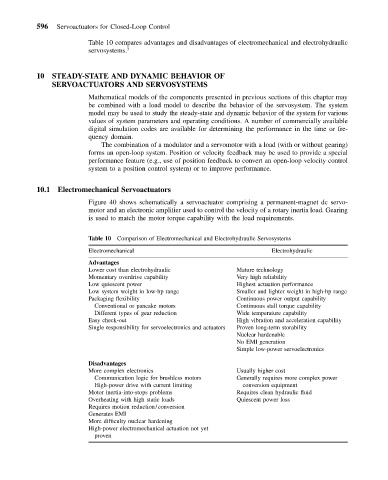Page 605 - Mechanical Engineers' Handbook (Volume 2)
P. 605
596 Servoactuators for Closed-Loop Control
Table 10 compares advantages and disadvantages of electromechanical and electrohydraulic
servosystems. 3
10 STEADY-STATE AND DYNAMIC BEHAVIOR OF
SERVOACTUATORS AND SERVOSYSTEMS
Mathematical models of the components presented in previous sections of this chapter may
be combined with a load model to describe the behavior of the servosystem. The system
model may be used to study the steady-state and dynamic behavior of the system for various
values of system parameters and operating conditions. A number of commercially available
digital simulation codes are available for determining the performance in the time or fre-
quency domain.
The combination of a modulator and a servomotor with a load (with or without gearing)
forms an open-loop system. Position or velocity feedback may be used to provide a special
performance feature (e.g., use of position feedback to convert an open-loop velocity control
system to a position control system) or to improve performance.
10.1 Electromechanical Servoactuators
Figure 40 shows schematically a servoactuator comprising a permanent-magnet dc servo-
motor and an electronic amplifier used to control the velocity of a rotary inertia load. Gearing
is used to match the motor torque capability with the load requirements.
Table 10 Comparison of Electromechanical and Electrohydraulic Servosystems
Electromechanical Electrohydraulic
Advantages
Lower cost than electrohydraulic Mature technology
Momentary overdrive capability Very high reliability
Low quiescent power Highest actuation performance
Low system weight in low-hp range Smaller and lighter weight in high-hp range
Packaging flexibility Continuous power output capability
Conventional or pancake motors Continuous stall torque capability
Different types of gear reduction Wide temperature capability
Easy check-out High vibration and acceleration capability
Single responsibility for servoelectronics and actuators Proven long-term storability
Nuclear hardenable
No EMI generation
Simple low-power servoelectronics
Disadvantages
More complex electronics Usually higher cost
Communication logic for brushless motors Generally requires more complex power
High-power drive with current limiting conversion equipment
Motor inertia-into-stops problems Requires clean hydraulic fluid
Overheating with high static loads Quiescent power loss
Requires motion reduction/conversion
Generates EMI
More difficulty nuclear hardening
High-power electromechanical actuation not yet
proven

